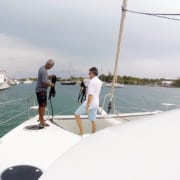Leaving the Slip
This is the first in a series of blogs on how to leave a slip or end tie. Some combinations of wind and current can get complicated and some are easy. The first shown below is the easiest. Stay tuned to this series and we’ll show all.
For all scenarios – Prior to push off:
- Start engine and ensure it is adequately warmed.
- Ensure everything is stowed
- No dock lines are in the water to tangle the prop.
- Center the wheel.
- Guests that do not have assigned jobs should be seated.
- Give clear instructions to each crew member on their coming tasks.
- Assess the wind and current direction at the slip so you can be prepared to keep control of the vessel under the prevailing conditions.
The following diagrams show you how to use wind and current to your advantage.
END TIES
(1) Wind pushing you away from the dock
This is the simplest scenario
- (A) Once you are confidently ready, release and stow docklines, then allow the wind to push the boat clear of other obstacles.
- (B) Engage the gear lever
- (C) Use enough power to overcome the effects from the wind. Head out to enjoy the day.
(2) Wind coming from behind
This is a little more tricky. If you try to go out forwards the wind could potentially push you into other boats. Additionally as you turn the wheel to head out, the rear of the boat will swing around towards the dock and other boats. therefore it is recommended that you reverse out using a spring line.
- (A) Once you are confident of your plan,
- appoint a crew member to use a fender at the front of the boat to prevent the boat from touching the dock.
- Release and stow the dock lines but leave one spring line from the dock near the center of the boat attached to the front of the boat.
- The spring line should be arranged so that it is attached to the forward cleat, runs freely around the dock cleat and returns back to the appointed crew member. In this manner the crew member can release the line and retrieve it by letting it slip around the dock cleat. ENSURE that there are no knots in the line to get caught on the dock cleat as it runs through.
- Turn the wheel towards the dock and engage forward gear.
- This will have the effect of pushing the rear of the boat away from the dock.
- (B) Once the boat has turned out from the dock, engage reverse and have your forward crew member release and retrieve the spring line.
- (C) Continue backing out to be completely clear before engaging forward gear. Remember the rear of the boat will swing back towards the dock once you engage forward and turn the wheel to windward, so ensure there is plenty of room.













